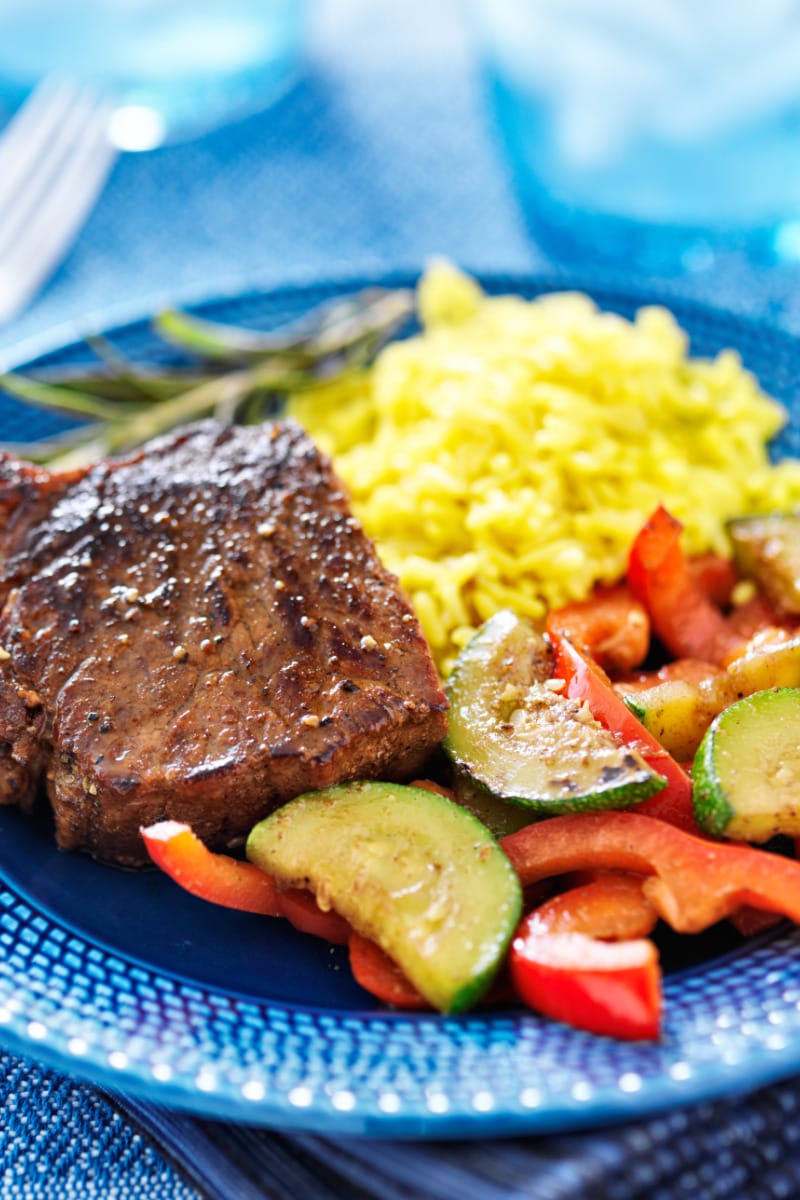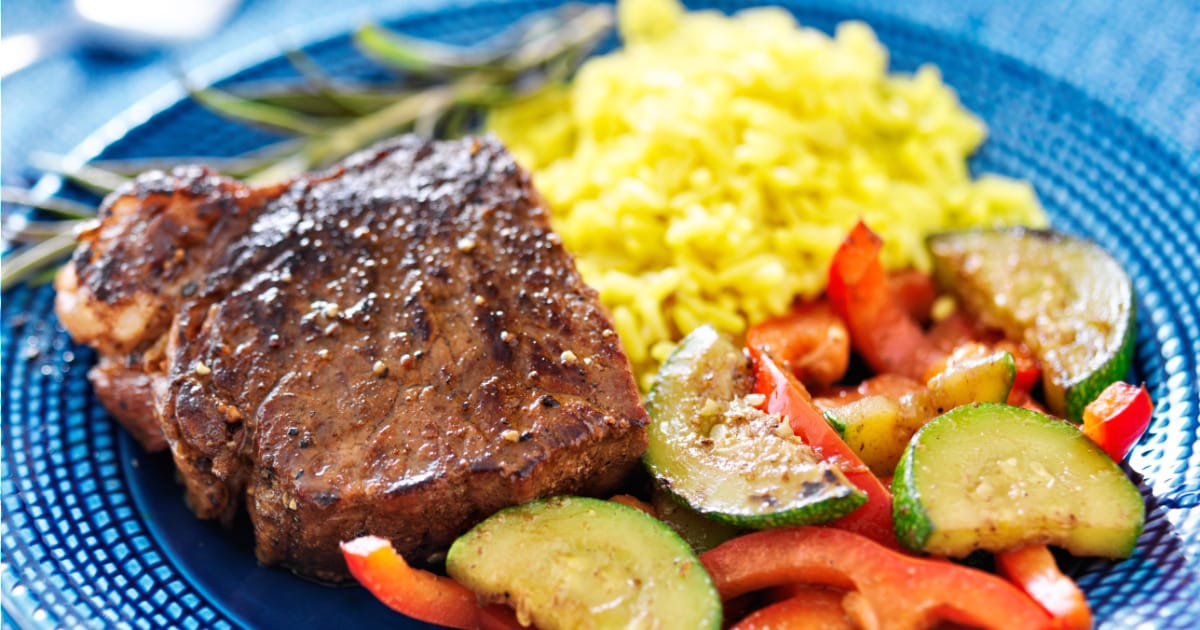Ready to cook a marinated, oven-roasted steak that would make Ron Swanson proud? This guide walks you through how to cook a perfect steak with easy, step-by-step instructions. The end result will be a caramelized, juicy, and melt-in-your-mouth steak.
Here are the steps:
- Choose the right cut of meat
- Mix a simple marinade
- Marinate the steak
- Bring the steak to room temperature
- Sear
- Finish in the hot oven
You will benefit from having these tools on hand:
- Meat thermometer to track the internal temperature
- Cast iron skillet or oven-safe skillet
Let’s dive into your prep steps.

1. Choosing the right cut
If this is your first time cooking marinated steak in the oven, it’s best to start with a more forgiving cut. Solid choices are:
- Ribeye: Ribeye (aka prime rib steak) is well-marbled, so it’s very moist and has great flavor.
- Sirloin steak: Sirloin is leaner than ribeye, but still has nice flavor. It’s also more affordable.
- Flat iron: Flat iron is tender and flavorful and easy on the budget.
Look for steaks that are at least 1 inch thick. Thinner cuts like flank steak and skirt steak cook very quickly, so they’re more suitable for the grill than the oven. (And of course, the process for cooking shaved steak is totally different because it’s so thin.) With a thicker piece of meat, you have the option to sear on the stove top first, which adds tons of flavor. You’ll then finish the cooking process in the oven.
2. Mix a simple marinade
The basic components of most steak marinades are oil, acid (like vinegar), herbs, and spices. For a dead simple marinade, mix 2 parts oil to 1 part red wine vinegar. Then add chopped fresh garlic, salt, and pepper.
If you prefer something more elaborate, try this:
- 1/4 cup soy sauce
- 2 tablespoons olive oil
- 2 tablespoons Worcestershire sauce
- 1 tablespoon balsamic vinegar
- 2 teaspoons Dijon mustard
- 2 cloves of garlic
- 1-2 teaspoons dried herbs like rosemary and thyme
- A few shakes of salt and pepper
You might also like our Qdoba steak marinade. It’s designed for flank steak, but it’s also delicious on thicker cuts.
3. Marinating your steak
Plan on marinating the steak for at least 30 minutes or overnight. You can put the steak and sauce into a flat, high-sided dish or a resealable plastic bag. If you’re marinating overnight, you’ll place the dish or bag in the refrigerator. See the next step if you’re marinating just before you cook the steak.
4. Let the steak come to room temperature
Here’s the secret to a tender, perfectly cooked steak: Let it come to room temperature before cooking. Simply remove the steak from the refrigerator and set it on the counter for 30 minutes. If you haven’t marinated the steak yet, you can use the 30 minutes to do that.
Steaks cook faster and more evenly from room temperature. When the meat is refrigerator-cold, the outside will cook faster than the inside. You might end up with a deep sear on the outside and a very rare middle. Also, the muscle fibers of a cold steak can contract and push the juices out of the meat. You don’t want that, as it can lead to a drier end result.
Remember to preheat your oven to 400°F or 204°C while your steak is resting on the countertop.
5. Sear
Searing steak in a hot skillet on the stove top adds flavor and texture. Make sure you use an oven-safe or cast-iron skillet, because after the sear, you’ll transfer the whole skillet into the oven to finish the cooking process.
Pro tip: You can use a grill pan for searing, to give your steak an attractive grill pattern.
Start by removing the steak from the marinade and patting it dry. Add a teaspoon or two of olive oil to a skillet and put it over a medium-high flame. Once the oil starts to shimmer, add the steak to the hot pan. Sear the steak for 1 minute, then use tongs to flip it. Sear the second side another minute. Then, using tongs, gently sear the edges of the steak.
Once you have a nice sear on all sides, lay the steak flat in the skillet. If you have a meat probe, insert it now. Then transfer the whole skillet to your preheated oven.
6. Bake in oven
Depending on the thickness of your steak, it can cook quickly in the oven. That’s why it’s helpful to use a meat probe — one with an alarm. As soon as the steak reaches your desired temperature, you want to remove it from the oven, fast.
And about that desired temperature…you will rest the steak for 10 minutes before you serve it. This helps redistribute the juices so the steak doesn’t dry out as soon as you cut it. During the resting time, the temperature will rise about 5 degrees.
Considering the 5-degree temperature rise, you can use the doneness chart below to determine when your steak is done. Ideally, you should rely on a thermometer — but if you don’t have one, use the touch method instead.
| Level of Doneness | Touch Method | Final Temperature |
| Rare: Steak center is cool and red. | The steak feels soft with some resistance when you touch it, like the fleshy part of your palm below your thumb. | 120–125°F (49–52°C) |
| Medium Rare: Steak center is warm and red. | The steak feels firm-ish, like pressing on the center of your palm. | 130–135°F (54–57°C) |
| Medium: Steak center is warm and pink. Steak will be firmer and less juicy than rare and medium-rare doneness. | A medium steak feels firmer than your palm center. It will be more like the base of your thumb when you bring your thumb and pinky finger together. | 140–145°F (60–63°C) |
| Medium Well: Steak center has very little pinkness. | A medium-well steak feels like the base of your thumb when you touch your ring finger and thumb together. | 150–155°F (66–68°C) |
| Well Done: There is no pink in the steak center. A well-done steak will be firm with a drier texture vs. less-cooked steaks. | A well-done steak will be as firm as the base of your thumb when all your fingers come together to touch your thumb. | 160°F (71°C) and above |
I would love to tell you exactly how long to cook steak in the oven to reach your desired doneness, but I fear that will do more harm than good. There are too many factors involved. So rely on the thermometer or the feel of the steak when you press it gently.
Below is an oven-baked steak recipe with printable card that summarizes how to cook marinated steak in the oven.
How to cook marinated steaks in the oven

This is an easy and delicious way to prepare steaks for dinner.
Ingredients
- 4 6-oz. steaks (ribeye, sirloin, or flat iron)
- 1/4 cup soy sauce
- 2 tablespoons olive oil
- 2 tablespoons Worcestershire sauce
- 1 tablespoon balsamic vinegar
- 2 teaspoons Dijon mustard
- 2 cloves of garlic, peeled and chopped
- 1-2 teaspoons dried herbs like rosemary and thyme
- Salt and pepper, to taste
Instructions
- Mix all ingredients but the steak into a marinating dish or resealable bag. Add the steak and refrigerate overnight.
- 30 minutes before cook time, take the steak out of the refrigerator and set it on the counter.
- Preheat your oven to 400°F or 204°C.
- Add 2 teaspoons of olive oil to a cast-iron or oven-safe skillet. When the oil is shimmering, remove the steak from the marinade, pat it dry, and place it in the hot skillet.
- Sear the meat for 1 minute per side. Use tongs to turn the steak and sear its edges as well.
- Lay the steaks flat and place the entire skillet in your hot oven. Cook until the steak reaches an internal temperature of 128°F or 53°C for medium-rare doneness. This may only take 5 minutes, so watch carefully.
- Let the steak rest for 10 minutes, then serve and enjoy.
Nutrition Information:
Yield:
4Serving Size:
1Amount Per Serving: Calories: 560Total Fat: 39gSaturated Fat: 13gTrans Fat: 0gUnsaturated Fat: 20gCholesterol: 165mgSodium: 1194mgCarbohydrates: 5gFiber: 1gSugar: 2gProtein: 46g
Nutrition information isn’t always accurate.
